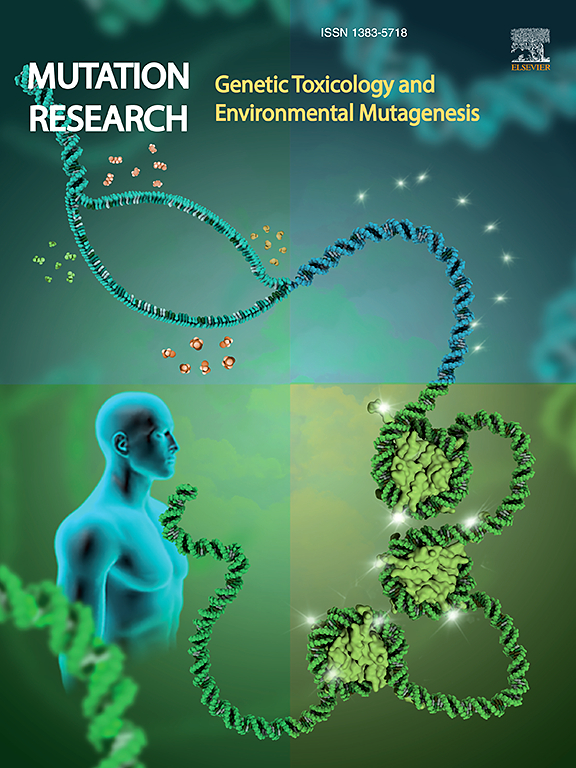Investigation of chemicals with inconsistent Ames results using miniaturized Ames test systems
IF 2.5
4区 医学
Q3 BIOTECHNOLOGY & APPLIED MICROBIOLOGY
Mutation research. Genetic toxicology and environmental mutagenesis
Pub Date : 2025-07-10
DOI:10.1016/j.mrgentox.2025.503874
引用次数: 0
Abstract
The Ames assay is a bacterial reverse gene mutation test that has been a cornerstone of mutagenicity assessment. The emphasis now is on developing miniaturized versions of the Ames test in Petri dish to require less chemicals, reagents, and liver microsomal S9 fraction, thus reducing the number of test animals needed and to better comply with 3R principles. Miniaturized Ames assay versions promote high throughput testing of multiple samples during compound screening and facilitate the early exclusion of genotoxic agents during the product development process. Existing experimental data shed light on a high concordance between results gained with miniaturized Ames tests and the Petri dish-based method, yet further testing is required to corroborate these findings. We selected compounds with previously reported inconsistent outcomes and assessed their mutagenic potential using two miniaturized Ames assay formats, an agar-based 6-well plate test, and a liquid microplate fluctuation format assay. Investigation of dose-response curves of known mutagens with varying bacterial cell density inputs revealed that the sensitivity of the 6-well agar plate format might be increased by applying the right bacterial cell density. Our analysis indicates an overall good correlation between the results acquired with the two miniaturized Ames assay formats despite the conceptual characteristic differences in the assay paradigms. Furthermore, the miniaturized Ames assay formats could detect several chemicals as positive at lower concentrations than the Petri dish-based assay. Our findings indicate that the miniaturized Ames assay variations show promise as a reliable method for assessing chemical mutagenicity, while also aligning with environmentally friendly testing strategies. Finally, our results show that the miniaturized assays may exhibit increased sensitivity to impurities, potentially contributing to the observed discrepancies in the obtained results.
使用小型Ames测试系统对具有不一致Ames结果的化学品进行调查
Ames试验是一种细菌反向基因突变试验,已成为致突变性评估的基石。现在的重点是在培养皿中开发小型化的Ames试验,以减少所需的化学品、试剂和肝微粒体S9分数,从而减少所需的试验动物数量,并更好地遵守3R原则。小型化的Ames检测版本在化合物筛选过程中促进了多个样品的高通量测试,并有助于在产品开发过程中早期排除基因毒性试剂。现有的实验数据表明,小型化Ames测试和基于培养皿的方法获得的结果高度一致,但需要进一步的测试来证实这些发现。我们选择了先前报道结果不一致的化合物,并使用两种小型化的Ames试验格式(琼脂基6孔板试验和液体微孔板波动格式试验)评估了它们的致突变性潜力。对已知诱变剂在不同细菌细胞密度下的剂量响应曲线的研究表明,适当的细菌细胞密度可以提高6孔琼脂平板格式的灵敏度。我们的分析表明,尽管在分析范式中存在概念特征差异,但在两种小型化的Ames分析格式中获得的结果之间总体上具有良好的相关性。此外,小型化的Ames检测格式可以在比培养皿检测更低的浓度下检测到几种化学物质的阳性。我们的研究结果表明,小型化的Ames试验变体有望作为评估化学诱变性的可靠方法,同时也与环境友好型测试策略相一致。最后,我们的结果表明,小型化的分析可能会对杂质表现出更高的敏感性,这可能会导致观察到的结果差异。
本文章由计算机程序翻译,如有差异,请以英文原文为准。
求助全文
约1分钟内获得全文
求助全文
来源期刊
CiteScore
3.80
自引率
5.30%
发文量
84
审稿时长
105 days
期刊介绍:
Mutation Research - Genetic Toxicology and Environmental Mutagenesis (MRGTEM) publishes papers advancing knowledge in the field of genetic toxicology. Papers are welcomed in the following areas:
New developments in genotoxicity testing of chemical agents (e.g. improvements in methodology of assay systems and interpretation of results).
Alternatives to and refinement of the use of animals in genotoxicity testing.
Nano-genotoxicology, the study of genotoxicity hazards and risks related to novel man-made nanomaterials.
Studies of epigenetic changes in relation to genotoxic effects.
The use of structure-activity relationships in predicting genotoxic effects.
The isolation and chemical characterization of novel environmental mutagens.
The measurement of genotoxic effects in human populations, when accompanied by quantitative measurements of environmental or occupational exposures.
The application of novel technologies for assessing the hazard and risks associated with genotoxic substances (e.g. OMICS or other high-throughput approaches to genotoxicity testing).
MRGTEM is now accepting submissions for a new section of the journal: Current Topics in Genotoxicity Testing, that will be dedicated to the discussion of current issues relating to design, interpretation and strategic use of genotoxicity tests. This section is envisaged to include discussions relating to the development of new international testing guidelines, but also to wider topics in the field. The evaluation of contrasting or opposing viewpoints is welcomed as long as the presentation is in accordance with the journal''s aims, scope, and policies.

 求助内容:
求助内容: 应助结果提醒方式:
应助结果提醒方式:


